Your voice is a wind instrument! Just like a flute or a trumpet, you need breath to produce sound. Air passes through your trachea (windpipe) and creates vibrations in your vocal folds to produce sound. When we speak, we don’t need a lot of air to make sound, but singing is a very different animal.
Diaphragmatic Breathing Technique For Singing
To create a strong, tension-free tone, trained vocalists use a breathing technique for singing called diaphragmatic breathing. The diaphragm is a flat, dome shaped muscle located at the bottom of your ribcage. It is the floor of your rib cage. When you inhale, the diaphragm descends, pulling air into your lungs. When you exhale, the muscle ascends and pushes air out of your lungs. This happens every time you breath. Your lungs are like bags of air and the diaphragm muscle helps pulls in air and push it out.
When we sing, we focus on using the diaphragm to inhale more deeply. A deeper inhalation leads to a stronger, fuller sound and illuminates tension in the throat.
What does a deep breath look like?
Stand in Front Of A Mirror and watch yourself breath in and out. You will probably notice that your shoulders and chest rise when you inhale and fall when you exhale. This is a shallow breath and is not good for producing a good vocal tone.
To take a deep singing breath, relax your abdomen as you fill with air and expand around the waist. You’ll feel this expansion in the muscles of your lower back as well. As you exhale, contract your stomach muscles slightly. I feel this contraction mostly in the upper abdomen muscles surrounding my diaphragm (above the belly button). Your shoulders and chest shouldn’t move as you breath. No need to hold them still, if you are breathing correctly they won’t move.
Breath Support- Your Ribs and Abdominal Muscles
When you sing, a steady stream of air is needed to produce a good vocal sound. Without it, your neck and throat will tense up in an effort to force the sound out. Remember, you are a wind instrument; you wouldn’t squeeze a flute to make the sound come out. The air passing through the open instrument and resonating is what produces the sound.
When you inhale deeply, your rib cage will expand. Your rib cage should stay open while your abdominal muscles contract slightly on the exhale. This is called breath support. It allows your diaphragm to ascend slowly, enabling you to sing longer phrases and have better control over pitch and tone. During a normal exhale, the diaphragm moves up quickly and all the air is expelled at once.
Stay Relaxed!
Keeping your body open and relaxed while singing is very important. The only tension you should feel is the slight tension in your abdominal muscles as you sing/exhale. Your posture should be upright, balanced and relaxed. If you are playing an instrument while singing, make sure your body isn’t bent over the instrument. I tell my students to picture a flute inside their bodies. Don’t bend or smoosh the flute.
How To Practice
Check out this article & video full of helpful tips and breathing exercises-
3 Easy Breathing Exercises For Singing







2 Comments
Vijay Patel
January 13, 2017Very good singing tips specially breathing exercise & videos. One can learn lot of from here. Thanks
Meghan Nixon
January 18, 2017Hi Vijay. I’m so glad I could help!
Leave A Response To Vijay Patel Cancel reply